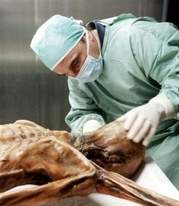Freezing living bodies may help humans reach immortality
Experiments conducted by Russian scientists show that survival of a living being is possible
People used to make fun of anabiosis in the past. There were quite a few trashy “sci-fi” books and films about freezing people and bringing them back to life in the future. There were only two people who did not use corny jokes while writing about anabiosis in the 1960s. Robert Attinger was one of them. He published a book titled "The Prospects of Immortality" in 1964. The famous Soviet surgeon Nikolai Amosov was the other one. Both of the above wrote about a distant future when scientists come up with ways of freezing the human body and warm it up without causing irreparable damage to its tissues. However, those two men were not the only scientists who were racking their brains over the problem. The Dutch self-taught scientist Anthony Van Levenguk was the one who showed original interest in what later became anabiosis. 
More than 300 years ago, on September 1, 1701, Van Levenguk spotted a phenomenon eventually called a “paradox of hidden life.” The scientist was looking at microorganisms as they lay under the lens of his microscope. The microorganisms, red wheel animalcules, would come back to life soon after some water was poured over the dry sand they lay in. They would look dead and listless once water began to dry out. They would be resuscitated by a drop of water over and over again.
Many a scientist conducted successful cold anabiosis experiments involving plants and simple life forms. But nobody ever succeeded experimenting with warm-blooded creatures. Let us carry out a couple of simple experiments to find out why all experiments with warm-blooded creatures always ended in failure.
Let us place a plastic bottle filled with water into a freezer. Then we will examine the contents of the bottle. We will see numerous large and small cracks running through ice. Size and shape of the cracks vary due to temperature fluctuations during the freezing and defrosting of water.
Now let us put an egg, a living object, into a freezer. A closer look at the thawed out egg will show the eggshell will be cracked all over and the contents of the egg will be damaged too. The egg will be irretrievably spoiled.
Things that happen to living cells during their freezing and defrosting resemble a horror movie. Ice crystals mangle the cell membranes, all inner structures are crushed and pierced through. That is why cryogenics never took off as a practical branch of science. A lack of rational idea entails a lack of funds. Science fiction technology does not entail financing.
Years ago a team of Soviet scientists headed by Academician Vladimir Kovanov carried out a series of spectacular experiments involving hypothermia of the warm-blooded animals. Drawing from the results of the experiments, the researchers came up with a theory of anabiosis for large living organisms.
The research was eventually terminated due to lack of financing after the collapse of the Soviet Union. Vladimir Kovanov passed away. The team broke up. The buzz stirred in the scientific world by the findings of the team died away.
Pavel Sherbakov, a former member of the team, shared his views about progress made by the Kovanov team in the research of human anabiosis. Sherbakov was the only member of the team who was specialized in the study of thermal properties of the living organism.
“We were the first ones who could reach the bottom level of hypothermiafor the warm-blooded organism at zero degrees Celsius. We were able to bring back to life 100% of animals subjected to freezing. The temperature was lowered to the freezing point of water. Then the temperature was raised to regular body temperature level. The minimum of zero degrees Celsius was maintained for 95 minutes. During that period of time animals were kept in a state of clinical death. The cardiac activity was reported to have stopped at three degrees Celsius.
“The results of the experiments show that a guinea pig will die if thawed at 0.6 degrees per minute after an abrupt freezing to 0 degrees Celsius. Thawing out the lab animal at 0.2 degrees per minute will kill it too. However, there is a 'window' of opportunity somewhere in between. All the laboratory animals survive if thawed at 0.4 degrees Celsius. All their vital functions get back to normal.”
“We drew up a diagram showing the temperature drops and surges of the fortunate situation resulting in complete survival of the animals. The temperatures drop sharply at the beginning. Then the temperatures rise slowly, they stay at a minimum of 0 degrees Celsius during that 95-minute period. My colleague jokingly dubbed the diagram a 'hypothermic hole.' The point is an animal can survive if it passes through that hole.”
“It sounds like a scientific sensation.”
“It certainly does. Our foreign colleagues all over the world regarded it as a remarkable discovery. For example, we received two letters from Dr. Ferrera, head of the laboratory of thermoregulation studies at the Claude Bernar University in France. He actually requested details of our findings because he doubted the media reports on our success in hypothermia experiments with the warm-blooded animals. Our work made headlines at the international media. Alas, scientists in this country gave us the cold shoulder.”
“We had to deal with yet another setback. I mean the so-called 'anabiotic hole.' Its minimum can reach the absolute temperature zero level, minus 237 degrees Celsius. It is more difficult to get out of the hole than dive in it. But a living organism can survive even under such harsh conditions. The experiments showed that survival was possible. We put hearts, blood and semen of the lab animals into an anabiotic capsule designed and built by our team. We used liquid nitrogen for freezing the specimens at minus 196 degrees Celsius. Then we brought them back to life by defrosting. Unfortunately, our research program came to a halt following the breakup of the Soviet Union.”
“Mr. Sherbakov, it seems that the findings and discoveries made by you research team have been in a lengthy state of anabiosis. What should be done to make them thaw?
“The answer is simple – money. But there is no point in looking for sponsors in the usual places. They would not allocate funds for projects that still look like science fiction.”
“Maybe you had better look for some moneybags who can pay for preserving their bodies until better times?”
"Maybe you are right, the idea is worth thinking over. I know that there are four cryonic companies operating in the U.S. They freeze the terminally ill at the request and expense of customers. Given the methods and lousy cryonic protectors used by those companies, they look like some weird funeral homes, as far as I am concerned. I wish we could set up a joint venture and use our super cryonic protector and their financial potential."
Discuss this article on Pravda.Ru English Forum
Subscribe to Pravda.Ru Telegram channel, Facebook, RSS!




